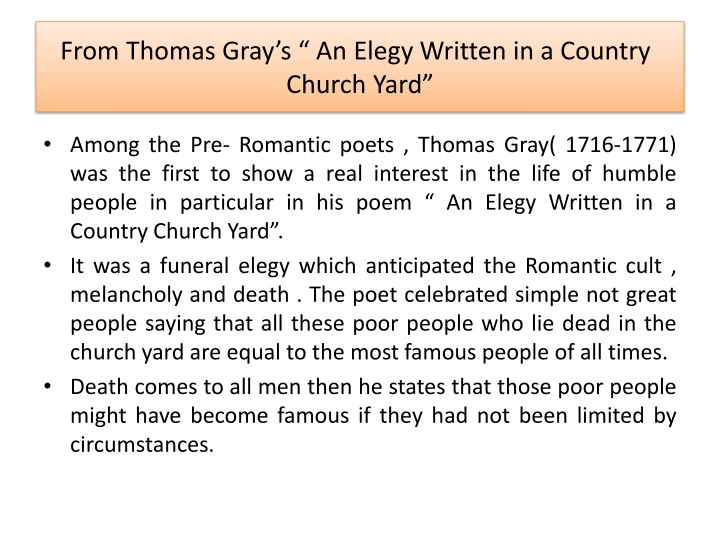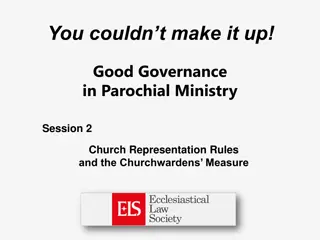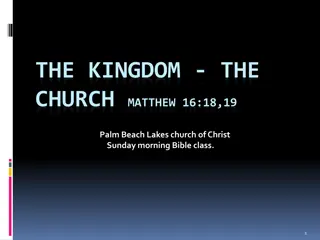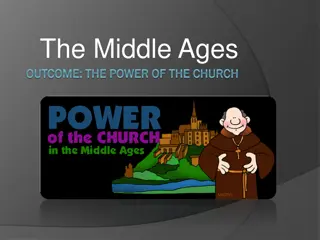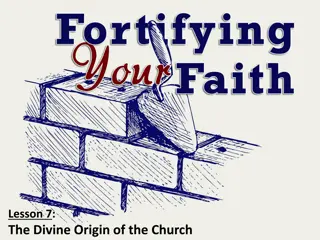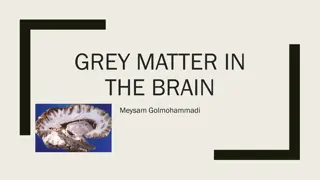Analysis and Structure of Thomas Gray's "An Elegy Written in a Country Church Yard
Thomas Gray's "An Elegy Written in a Country Church Yard" is a pre-Romantic poem that reflects on the lives of humble individuals buried in a churchyard. The poem explores themes of death, melancholy, and the equality of all people in the face of mortality. Gray's elegy is structured in four-line stanzas with a distinct rhyme scheme and pace, emphasizing the solemnity of the subject matter. Through detailed descriptions of the setting and reflections on life and death, Gray's poem captures the poignant beauty of the countryside and human existence.
Uploaded on Sep 27, 2024 | 7 Views
Download Presentation

Please find below an Image/Link to download the presentation.
The content on the website is provided AS IS for your information and personal use only. It may not be sold, licensed, or shared on other websites without obtaining consent from the author.If you encounter any issues during the download, it is possible that the publisher has removed the file from their server.
You are allowed to download the files provided on this website for personal or commercial use, subject to the condition that they are used lawfully. All files are the property of their respective owners.
The content on the website is provided AS IS for your information and personal use only. It may not be sold, licensed, or shared on other websites without obtaining consent from the author.
E N D
Presentation Transcript
From Thomas Grays An Elegy Written in a Country Church Yard Among the Pre- Romantic poets , Thomas Gray( 1716-1771) was the first to show a real interest in the life of humble people in particular in his poem An Elegy Written in a Country Church Yard . It was a funeral elegy which anticipated the Romantic cult , melancholy and death . The poet celebrated simple not great people saying that all these poor people who lie dead in the church yard are equal to the most famous people of all times. Death comes to all men then he states that those poor people might have become famous if they had not been limited by circumstances.
From Thomas Grays An Elegy Written in a Country Church Yard The poem ends with the supposed death of the poet , his burial in the same churchyard of Stoke Poges , England . The epitaph on his tomb could be read as Gray s summing up of his own life and beliefs.
Structure of the poem It is a long poem written in four line stanzas or quatrains in which the first line rhymes with the third , the second with the fourth . At the time , this abab pattern was associated with elegies. It is what gives the poem a stately pace .The last three stanzas are printed in Italic type and given the title The Epitaph .
The Setting It is the country churchyard of Stoke Porges , England. Time is the quiet evening as the night is descending. The poet is standing in that churchyard as we are told . He is meditating on the life and death of humble villagers whose graves surround him .
Analysis of L 1-12 The poet sets the scene for his quiet meditations. He is far from the city and is looking at a rural scene from a country churchyard. But , the sight and sounds of that rural world of men and beasts fade away. The scene is beautiful but life is not joyous . The poet reflects that the day dies just like the one before as the plowman plods wearily home. The poet is alone but he is not tired. The scene is quiet except for few things which disturb the poet like the tinkling of the cattle , the drone of beetle and the sound of an owl from the church tower. The moping owl has been a solitary ruler over the churchyard since ancient times. It is an ominous note the poet is challenging its reign.
L13-28 The poet uses the churchyard scene to invoke important images : the strength of the elms , death as symbolized by the graves and the comfort provided by the yews shading bodies that sleep. The poet reflects that death for the humble and lower classes means a cessation of life ; simple pleasure : waking up to the songs of birds , sharing life with wife and children and enjoying productive work .It is not untimely death but that it comes after a normal life span.
L29-52 The poet addresses the upper classes those with ambition , power , pride and exhorts them not to mock the poor for their simplicity or for not having elaborate statues on graveyard memorials. He tells that those upper class people will die just like the poor no matter what glory they achieve or how elaborate tomb stones they will have. There is a message that the poor are born with the same natural abilities as the upper class people. The poet implies that the innocence and beauty of those souls wasted in their isolated rural environment & resembling hidden deserts , oceans , caves could have flourished in a better circumstances . The poet then laments that the poor die before they can make a mark on the world.
